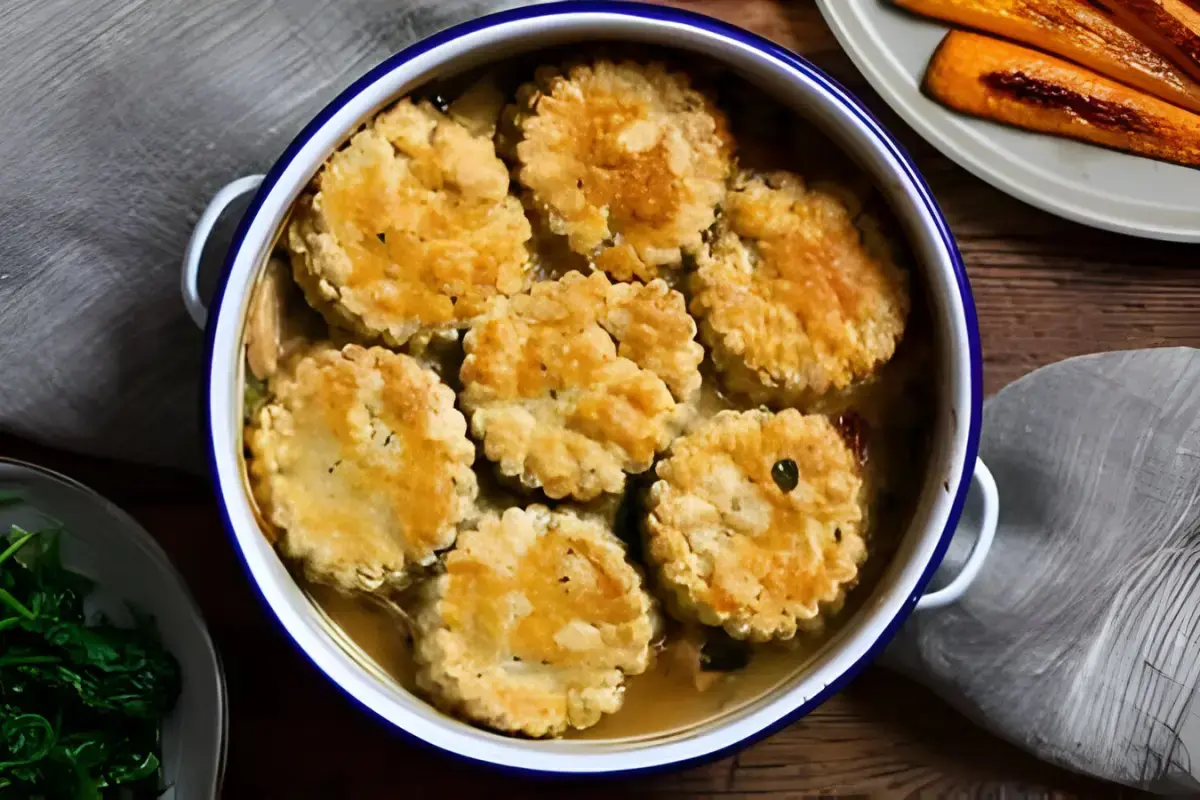Diving into the cozy world of desserts, there’s truly nothing that beats the comforting embrace of a warm cobbler. This beloved dish, rich in history and simple yet mouthwatering ingredients, stands as a testament to the sheer joy of baking. It combines fruit, dough, and a sprinkle of sweetness in a way that feels like home. In this comprehensive guide, we’ll peel back the layers of cobbler, exploring its essence, tracing its origins, and discovering the variations that make every bite a unique delight. So, let’s crank up those ovens and get ready to master the art of crafting the perfect cobbler.
Part 1: Introduction to Cobbler
What is a Cobbler?
At its heart, cobbler is a quintessential American dessert, though its roots and variations stretch far and wide. Defined by its luscious fruit filling and a topping of biscuit, dough, or batter baked until golden, cobbler embodies the spirit of home cooking. Unlike its relatives, crisp and crumble, cobbler’s topping offers a hearty contrast to the tender, juicy fruit below.
For those intrigued by the versatility of dough and its impact on desserts, our exploration of cookie mix vs. cake mix provides further insight into the art of baking, offering a perfect complement to the cobbler discussion.
Brief History of Cobbler
The story of cobbler begins in the early 19th century, threading through the fabric of American culinary tradition. Initially a way to savor the summer’s fruit bounty, cobblers gained popularity in the American South. Cooks there baked them in large communal pots. The name suggests a dish “cobbled” together from whatever ingredients were on hand, highlighting the creativity of home cooks.
As we delve into the rich tapestry of this dessert’s history, it’s clear that cobbler is more than just a dish; it’s a culinary journey that mirrors the evolution of American baking. For those interested in the historical aspects of culinary traditions, our guide on mastering the chicken pot pie sauce offers a glimpse into another beloved dish that has stood the test of time, much like the cobbler.
In the following sections, we’ll uncover the classic ingredients of a cobbler, explore its regional twists, and offer tips for making your own. Whether you’re an experienced baker or a newcomer to the kitchen, there’s a cobbler story waiting to unfold in your oven. Let’s embark on this tasty adventure together, celebrating the joys of cobbler and the boundless creativity it inspires.
Ingredients and Variations
Main Ingredients of Cobbler
Cobbler thrives on simplicity. The main stars? Fruit, sugar, and a topping that bakes into a crusty delight. Let’s break it down:
- Fruits in Cobbler: The soul of any cobbler, fruits range from peaches to berries, depending on what’s in season. The key? Use ripe, juicy fruits for that perfect sweet and tangy balance.
- Dough, Biscuit, and Batter Variations: Here’s where the magic happens. Some cobblers sport a biscuit topping that is fluffy and light. Others go for a smoother batter, creating a cake-like crust. Each brings its own texture and taste to the table.
Regional Variations of Cobbler
Cobbler wears many hats, changing with the landscapes and traditions of its makers.
- Southern Cobbler Traditions: In the South, cobblers often feature a dense, pie-like crust, sometimes even lining the bottom of the dish. Peaches reign supreme here, embodying the essence of Southern comfort.
- Modern Interpretations and Variations: Today’s cobblers are adventurous. Chefs and home cooks alike experiment with everything from mixed berries to exotic fruits. Toppings have evolved too, with ingredients like cornmeal or nuts adding a modern twist.
Cobbler’s beauty lies in its versatility. Whether sticking to tradition or venturing into new combinations, the possibilities are endless. So, why not grab some seasonal fruits and start experimenting? Your perfect cobbler awaits.
Making a Cobbler
Preparing the Fruit
First off, selecting the right fruits is crucial. Look for those that are ripe and bursting with flavor. After all, they’re the heart of your cobbler. Peaches, berries, apples, or cherries? The choice is yours, but remember, the best cobbler sings with the season’s bounty.
Now, onto preparing those fruits for baking. Peel and slice, if needed, and toss them with sugar and a bit of flour or cornstarch. This mix not only sweetens but also thickens the fruit juices, creating a luscious filling. A dash of lemon juice can add a bright note, balancing the sweetness.
Creating the Topping
Then, we move to the crowning glory: the topping. The biscuit topping, fluffy and tender, offers a delightful contrast to the fruit. Alternatively, a cake batter topping spreads smoothly, baking into a soft, sweet crust.
For the perfect crust, keep a few tips in mind. If you’re going the biscuit route, don’t overwork the dough; a light touch keeps it tender. For a cake batter topping, smooth it gently over the fruit, allowing room for it to expand as it bakes.
Regardless of your choice, both toppings bake into a golden, delicious crust, making every spoonful of cobbler a perfect harmony of flavors and textures. So, why not dive in and start experimenting? The perfect cobbler, after all, is just a bake away.
Cobbler, Crisp, and Crumble: Understanding the Differences
Navigating the delicious world of fruit desserts can sometimes feel like deciphering a complex code. However, once you get the hang of it, distinguishing between a cobbler, a crisp, and a crumble becomes as easy as pie—or should we say, cobbler? Let’s dive in and clear up the confusion.
Cobbler
A cobbler is a comforting, hearty dessert with a topping that’s baked until golden and often resembles a mosaic of biscuit dough. The key ingredients? Ripe fruits, sugar, and a dough that puffs up beautifully, offering a satisfying contrast to the juicy fruit beneath.
Crisp
What sets a crisp apart is its topping: a mixture of butter, sugar, flour, and often oats, which crisps up during baking to create a texture that’s, well, crisp. This dessert leans on the crunchier side of things, providing a delightful contrast to the soft fruit base.
Crumble
A crumble is akin to a crisp, but its topping tends to be more like streusel, lacking oats and offering a sandier, softer texture. The ingredients are simple: butter, sugar, and flour combined to create clumps that bake to a gentle golden brown.
Comparative Analysis
While all three desserts share the common ground of fruit and a baked topping, the differences lie in the textures and ingredients of their crusts. A cobbler has a more biscuit-like topping, offering a soft and fluffy contrast. Crisps include oats in their topping, which gives them their signature crunch. Crumbles, on the other hand, forgo oats for a simpler, more streusel-like topping, resulting in a softer bite.
Despite these differences, each dessert allows the fruit to shine, transforming into a bubbling, aromatic delight that’s hard to resist. Whether you prefer the biscuity softness of a cobbler, the crunchy texture of a crisp, or the sandy softness of a crumble, there’s no denying the appeal of these classic fruit desserts. So, why not explore all three and find your favorite? After all, in the world of baking, variety is indeed the spice of life.
FAQs
What fruits work best?
The ideal candidates for this dessert are fruits that offer a sweet yet slightly acidic flavor profile and can withstand the baking process. Peaches, berries, apples, and cherries are excellent choices. The beauty of this dish lies in its adaptability; feel free to experiment with different fruits based on what’s in season or your personal tastes.
Using frozen fruits?
Yes, frozen fruits are a fantastic, convenient option for making this dessert year-round. They may release more liquid than fresh fruits, so consider adding a bit more thickener to your fruit mix to maintain the perfect consistency.
Preventing a Soggy Bottom
To avoid a soggy outcome, make sure your fruit mix isn’t too wet before it goes into the oven. For juicier or frozen fruits, a thickener like cornstarch or flour can be your best friend. Ensuring the dessert bakes until the topping is golden brown allows the heat to properly crisp the top, avoiding sogginess.
Dessert vs. Pie: Spotting the Difference
Though both celebrate fruit, the distinction lies in their crusts. Pies typically feature a flaky pastry crust beneath and sometimes atop the filling. This dessert, however, boasts a biscuit-like or cake-like topping laid over the fruit before baking, offering a rustic and comforting texture focused more on the fruit’s flavor than on pastry precision.
By focusing on these aspects and reducing the repetition of the specific dessert name, we maintain a rich, informative section that adheres to SEO guidelines without overoptimizing.
Conclusion and Final Thoughts
For those looking to perfect their cobbler game, diving into Bon Appétit’s Guide to Baking Cobblers offers “Expert Baking Tips for Perfect Cobblers,” ensuring your next dessert is not just good, but great. Meanwhile, understanding the broader context of this dish within the panorama of American sweets, The Evolution of American Desserts provides a fascinating journey through time. And for those who crave a deeper understanding of cobbler’s culinary nuances, Fine Dining Lovers’ Cobbler Insights offers a “Culinary Deep Dive into Cobbler,” enriching your knowledge and perhaps your recipe book.
The journey through the world of cobblers brings us to a sweet conclusion. The joy of making and eating cobbler lies not just in its delicious taste but also in the warmth and comfort it brings to our tables. This humble dessert, with its rich history and simple ingredients, invites us to celebrate the bounty of the seasons and the pleasure of home cooking.
Cobbler is a testament to the creativity of cooks across generations, a dish that encourages experimentation and adaptation. Whether you’re a fan of the classic peach cobbler or eager to explore combinations of berries, apples, or even exotic fruits, the possibilities are endless. And it’s not just the fruits; experimenting with toppings—from biscuits to cake batter—can transform your cobbler experience.
So, as we wrap up this guide, let’s carry forward the spirit of innovation that defines cobbler. Let’s mix, match, and create new traditions, one delicious spoonful at a time. Whether you’re serving it at a family gathering or enjoying a quiet moment alone, cobbler is more than just a dessert; it’s a celebration of flavor, history, and the joy of baking. Here’s to many more delightful cobbler creations!


